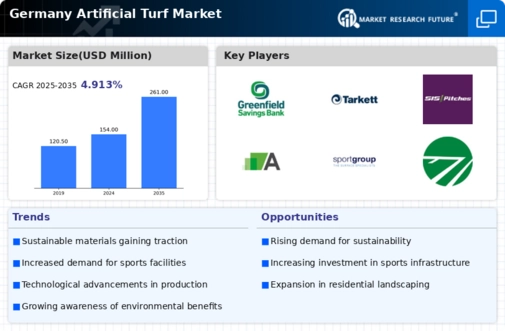Growing Demand for Sports Facilities
The increasing interest in sports and recreational activities in Germany is driving the demand for artificial turf. As municipalities and private entities invest in sports facilities, the artificial turf market experiences growth. In 2025, the market is projected to reach approximately €300 million, reflecting a robust annual growth rate of around 8%. This trend is particularly evident in urban areas where space is limited, making artificial turf an attractive option for creating multi-use sports fields. The artificial turf market benefits from this demand as it provides a durable and low-maintenance solution for various sports, including football, hockey, and tennis. Furthermore, the rise of community sports programs and youth leagues contributes to the expansion of artificial turf installations, enhancing the overall market landscape.
Environmental Regulations and Standards
Germany's stringent environmental regulations are influencing the artificial turf market. The government promotes sustainable practices, which encourages the adoption of eco-friendly materials in artificial turf production. As of 2025, approximately 30% of new installations are expected to utilize recyclable materials, aligning with Germany's commitment to sustainability. The artificial turf market is adapting to these regulations by innovating products that meet environmental standards, thus appealing to eco-conscious consumers. Additionally, the push for reducing water usage in landscaping and sports facilities further supports the transition to artificial turf, which requires significantly less water compared to natural grass. This regulatory environment not only fosters growth but also enhances the reputation of the artificial turf market as a responsible choice for environmentally aware consumers.
Rising Popularity of Landscaping Solutions
The trend towards low-maintenance landscaping is significantly impacting the artificial turf market in Germany. Homeowners and businesses are increasingly opting for artificial turf as a solution to reduce maintenance costs and water consumption. In 2025, it is estimated that the residential segment will account for nearly 40% of the total market share, driven by the desire for aesthetically pleasing outdoor spaces without the upkeep associated with natural grass. The artificial turf market is responding to this demand by offering a variety of products tailored for landscaping, including options that mimic the appearance of natural grass. This shift not only enhances the market's appeal but also aligns with broader trends in sustainable living and resource conservation.
Increased Investment in Sports Infrastructure
Investment in sports infrastructure is a key driver for the artificial turf market in Germany. The government and private sector are allocating substantial funds to upgrade and build new sports facilities, which often incorporate artificial turf. By 2025, it is projected that investments in sports infrastructure will exceed €1 billion, with a significant portion directed towards artificial turf installations. The artificial turf market stands to benefit from this influx of capital, as it enables the development of high-quality sports surfaces that meet international standards. This trend is particularly relevant for football and rugby, where the demand for reliable playing surfaces is paramount. As more facilities adopt artificial turf, the market is likely to experience sustained growth, driven by both public and private sector initiatives.
Technological Innovations in Product Development
Technological advancements are reshaping the artificial turf market in Germany. Innovations in materials and manufacturing processes are leading to the development of more realistic and durable turf options. For instance, advancements in tufting technology and the introduction of new polymers have improved the performance and longevity of artificial grass. By 2025, it is anticipated that the market will see a 15% increase in the adoption of high-performance turf products. The artificial turf market is capitalizing on these innovations to cater to diverse consumer needs, from residential lawns to professional sports fields. Furthermore, the integration of smart technologies, such as temperature regulation and drainage systems, enhances the functionality of artificial turf, making it a more appealing choice for various applications.






















Leave a Comment